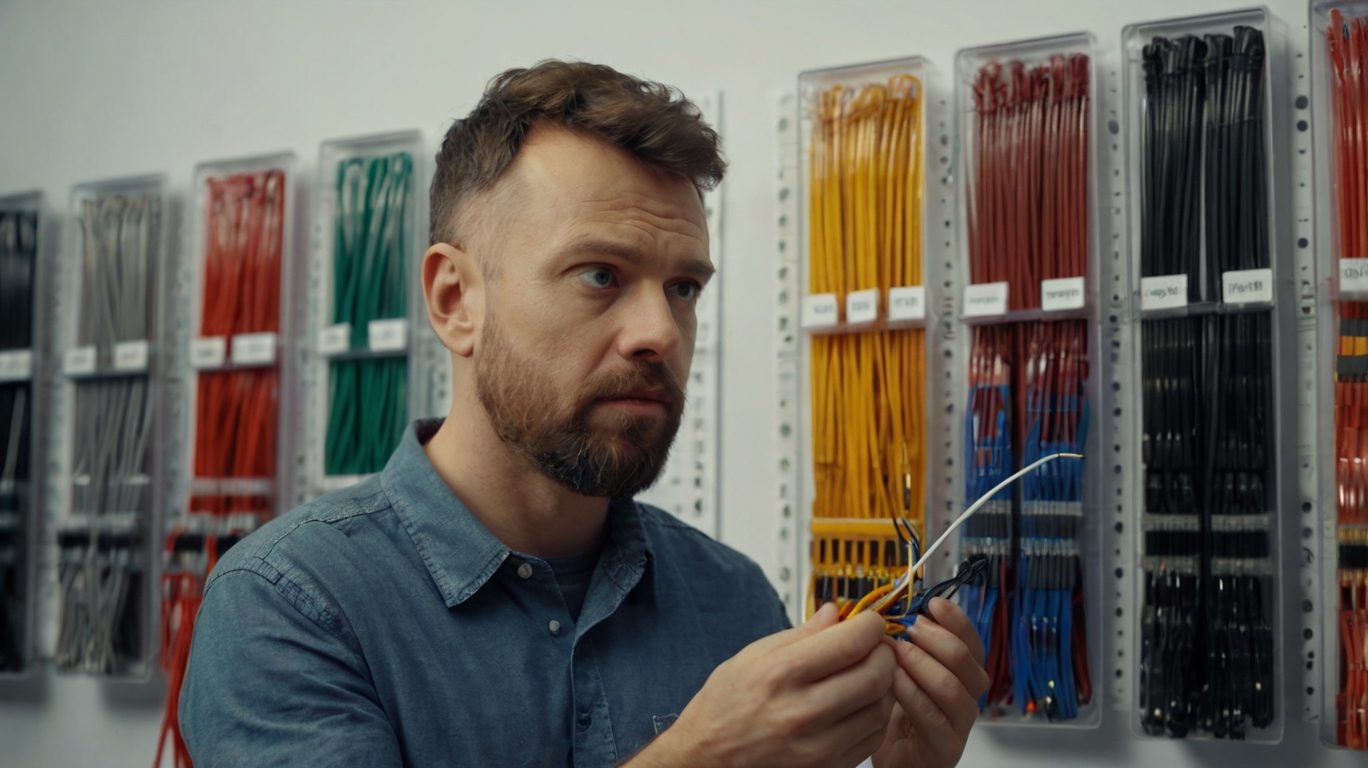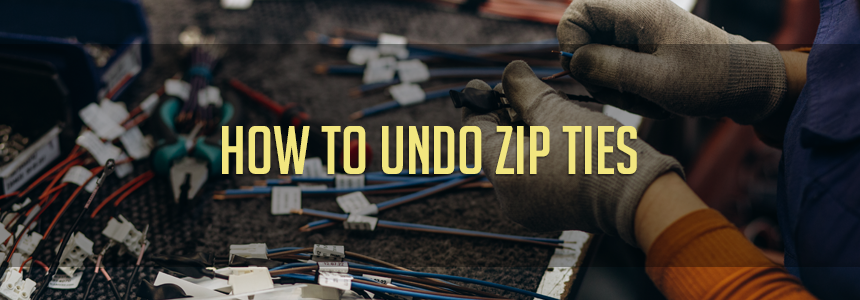Cable Tie Showdown: Self-Locking Vs. Reusable, How To Choose

Reader Summary: We compared self-locking and reusable cable ties against each other in this ultimate showdown. See which type of cable tie holds stronger, handles better, and performs the best in the real world. Explore how we tested, ranked, rated, and awarded each cable tie, so you know exactly which one your next project needs —whether you’re bundling cables or securing components with wire tie solutions.
Cable Tie Showdown: Self-Locking Vs. Reusable, How To Choose
Two cable ties. Two different approaches. One locks in forever, the other adapts on demand, but which one actually delivers when it matters most?
We put self-locking and reusable cable ties to the test, evaluating durability, flexibility, and real-world performance to help you make the smartest choice.
Here’s what we found.
Product Breakdown
Choosing the right cable tie can make or break your project.
At first glance, self-locking and releasable cable ties seem similar. They share core functions: securing, bundling, organizing, hoisting, and holding. Both types of tie have long tails with serrated edges that loop into locking heads. Both share a familiar “pull to tighten” motion. But their differences go beyond appearance. Each is built for a specific purpose.
But do you need a permanent hold with unshakeable stamina? Or are you looking for something strong and forceful that lets you adjust as you go?
There’s more to cable ties than just locking and forgetting–unless, of course, that’s what you’re going for. Let’s break down their features, specs, and perks, side-by-side, for a better look and the best choice.
Self-Locking Cable Ties–Designed for Maximum Hold
If your jobs (or preferences) are of the “one-and-done” variety, self-locking cable ties are for you. These guys are built for strength and stability. Their heads feature a one-way, built-in ratcheting mechanism. Once you slip the tail into the pawl and pull tight, they lock down, lock in, stay shut, and stay put. That means no worries about tension, temperatures, or the test of time wiggling them loose–ever.
Here’s a look at their specs and perks:
- Material: Nylon 6.6
- Tensile Strength: 18 - 250 lbs
- Temperature Resistance: -40°F to 185°F
- UV Resistance: Available in black for outdoor compatibility
- Sizes: 4” - 40”
- Colors: 15 vibrant shades, 5 of which are fluorescent
Reusable Cable Ties–Made for Mobility.
Don’t let the reusability option of these guys throw you off. Releasable reusable cable ties are made from the same strong, durable Nylon 6.6 as their self-locking counterpart. That means they hold up and hold on under the same temperature conditions. They’re also fiercely flexible with a trigger-release tab that allows for multiple fastening cycles. This makes them quicker, more convenient, and wildly versatile.
So, if your wiring, wrangling, and wrapping needs tend to change on a dime (or your mind does), these are the cable ties you want on the job.
Here’s a look at their specs and perks:
- Material: Nylon 6.6
- Tensile Strength: 40 - 50 lbs
- Temperature Resistance: -40°F to 185°F
- UV Resistance: Available in black for outdoor compatibility
- Sizes: 6” - 14”
- Colors: Black & Natural (or up to 6 colors in 120pc bags of 6” and 8” ties)
Performance Testing
Cable ties do more than bundle cables, wires, and household items—they’re all-around handy helpers built to perform. That means standing up to pressure, handling in fast-moving environments, and flexing with the best (and worst) applications.
To put them to the test, we examined how self-locking and reusable cable ties perform when stretched to their limits, repositioned under stress, and used across industries where failure isn’t an option.
Choosing the right type of cable tie isn’t just about preference; it’s about performance…and here’s how each stacks up.
Round 1: Strength & Durability – Which Holds Up Under Pressure?
When a cable tie snaps, slips, or falls, the frustration is instant, but the damage could be irreversible. Failed cable ties are costly mistakes. They can cause disrupted installations, unsecured wiring, or compromised structural integrity. None of that is acceptable, and all of it is dangerous.
Cable ties have to be strong and reliable, because when you hoist something heavy, you need to know—can it handle the load?
A cable tie’s brute, mechanical holding force (at rest or under pressure) is measured by loop tensile strength. These weights (in lbs) aren’t just guesswork. They’re industry standards. The National Electrical Manufacturers Association (NEMA) and Underwriter Laboratories (UL) set safety standards for electrical equipment and accompaniments, like cable ties.
At BuyHeatShrink.com, we list our cable ties by loop tensile strength, so you know exactly what to expect.
Here’s a side-by-side comparison of the two contenders.
Loop Tensile Strength Testing:
- Self-Locking Cable Ties: 18 - 250 lbs
- Reusable Cable Ties: 40 - 50 lbs
The Winner:
Round One: Strength & Durability GOES TO Self-Locking Cable Ties!
We appreciate the effort of reusable cable ties to hold up well in temporary setups, but they simply can’t match the muscle and stability of self-locking ties.
With their superior loop tensile strength up to 250 lbs, self-locking cable ties dominate in raw strength and durability. Their ratcheting mechanism keeps loops locked and grips secured. That means there’s no chance of loosening under strain or slipping mid-task. This makes self-locking ties the confident choice for heavy-duty, permanent installations like automotive setups, electrical wiring, and industrial bundling.
With strength and durability locked in, self-locking cable ties are a standout winner for high-pressure applications. But sheer force isn’t the only factor that matters.
Let’s see how each cable tie fares, head-to-head, in flexibility and handling.
Round 2: Handling & Flexibility – Which Makes Life Easier?
Hard-to-handle cable ties aren’t just an inconvenience. They’re an efficiency drain. When cable ties are too stiff or too hard to fasten, they can’t be installed quickly. Extra time, awkward adjustments, and extra delays for repairs and maintenance. Reconfigurations, replacements, and repairs. It all adds up quickly–and none of it is good.
Cable ties need to be effortless to be truly effective in the long run. Strong is great, but so is convenience. The right cable tie should fasten quickly, adjust easily, and work without frustration.
Workplace efficiency isn’t just an abstract idea. It means having the right tools on the job with you, and it’s a scientific discipline called ergonomics.
Tools that reduce strain, improve handling, and boost productivity are the foundation of ergonomic design. That includes cable ties, too. When you adopt efficiency tools that work better, tasks get done faster. Streamlining processes is smart for businesses, bottom lines, and employee (or personal!) happiness.
This round is all about handling and flexibility. We’ve spent a lot of hands-on time with self-locking and reusable cable ties. We rated each based on overall user-friendliness in real working conditions. So, which cable tie is going to make your life easier?
Cable Tie Convenience Ratings (out of 10):
- Self-Locking Cable Ties
- Handling: 7 – firm grip, but rigidity trumps ergonomics during high-frequency use
- Flexibility: 6 – easy to bend with a little stiffness, decent conformity to irregular shapes
- Installation Speed: 8 – fast and easy to lock into place with minimal effort
- Adjustability: 3 – once secured, there’s no loosening or repositioning, single-use only
- Reusable Cable Ties
- Handling: 8 – smoother, more comfy grip that’s easier on the hands
- Flexibility: 8 – slightly more bend and pliability with better conformity to irregular shapes (and surfaces)
- Installation Speed: 7 – less aggressive grip feels less “snap-secure,” slightly slowing install time
- Adjustability: 10 – fully releasable, repositionable, and reusable, no waste, just pure convenience
The Winner:
Round Two: Flexibility & Handling GOES TO Reusable Cable Ties!
We applaud self-locking cable ties for everything they bring to the table. They are convenient, but they lack the effortless ergonomics and efficiency of releasable reusable cable ties. With their increased pliability and full repositionability, reusable cable ties are the clear winners here.
We love that reusable ties are zero-waste–a win for your budget and the environment. They’re also gentler on hands and time, especially during potential repairs or adjustments. This makes releasable, reusable ties the undisputed champion for dynamic setups, adaptable storage solutions, temporary wiring, and quick or frequent repairs on the fly.
The supreme flexibility and handling of reusable cable ties take the cake for convenience. So here’s the final showdown–which cable tie is the best real-world performer?
Round 3: Best Use & Performance – Where Do They Shine?
Our brains are wired for winning. We crave excellence, motivation, and the satisfaction of knowing we made the best possible choice.
Awards provide validation and positive, meaningful reinforcement. Psychology shows that awarding the “best” titles simplifies decision making and reinforces trust in superiority. That makes this last round an easy one.
Let’s take a moment to recognize some (slightly arbitrary, yet) intensely informative WINNING Cable Tie Award Categories.
We all love to win–and so do our cable ties.
Cable Tie Awards Lineup:
- Self-Locking Cable Ties
- Best for High-Stakes Installs–where failure is not an option
- Best for Mission Critical Applications–when safety and reliability are top priorities
- Best for Extreme Conditions–unshaken by heat, cold, or pressure
- Best for Rugged Reinforcements–built to last
- Reusable Cable Ties
- Best for Budgets & Sustainability–save money, save the Earth
- Best for Adaptation–for ever-evolving setups
- Best for High-Efficiency Workflows–built for speed and seamless integrations
- Best for Indecision & Unconvention–no clue, no plan, no problem, no regrets
The Winner:
Round Three: Best Use & Performance GOES TO…well…where exactly are you?
There’s no way we could call a winner for round three. The most important factor here, is you–and where exactly you expect your cable ties to perform.
If you’ve got rugged terrain, heavy-duty tasks, and some extreme securing ahead, self-locking cable ties are the best for you. They won’t let you down.
If your work horizon is ever-changing, unpredictable, and in need of some adaptive strength, reusable cable ties will be the best for you. They keep up with life.
When it comes to best use and real-world performance, we’re splitting this one 50/50. Both self-locking and reusable cable ties shine in their own environments and “Best for” applications. No matter which cable tie you choose, you’ll be getting reliability, strength, and some convenient bundling and organization. There’s no wrong choice, just the best personal fit.
But if you keep reading, we’ll share a secret so you may never have to choose.
Secret Tip
Think self-locking cable ties are a one-use item? Let’s revisit that.
It’s true, most people cut off self-locking cable ties after a single use and toss them. But with a little finesse and these special tips, it’s possible to unlock, open, and reuse them. Here are two simple ways to release that self-locking cable tie and a little MacGyver energy.
- The Flathead Hack: Use a small flathead screwdriver to lift the locking tab, slide the tail out smoothly, and you’re good to go.
- The Paperclip Trick: Insert a thin object (like a paperclip) under the ratchet mechanism (or pawl) to release it.
Try each method and pick the one that works best, or first. If your self-locking cable ties resist, add a little wiggle and give it another go–it works, we promise! Still can’t unlock it? They’re cost-effective enough not to stress. Just snip it off in the middle and replace it.
But this time, are you reaching for a self-locking cable tie or a reusable one?
Final Verdict
Two different cable ties. Two different approaches.
We checked out self-locking and reusable cable ties for best on the job performance. We pitted them against each other to evaluate their loop tensile strength, durability, flexibility, and handling.
Both competitors are quick, convenient, and reliable. One dominates in formidable holding strength. The other triumphs in reuse and adjustability. The truth is, it’s too close to call. So the real question is, which one works best for you?
Whether you grab self-locking or reusable, there’s a cable tie ready to meet your toughest challenges. Then again, nothing is stopping you from having the best of both worlds.
Why choose just one? Stock up today at BuyHeatShrink.com—because in this showdown, every cable tie proves its worth.














